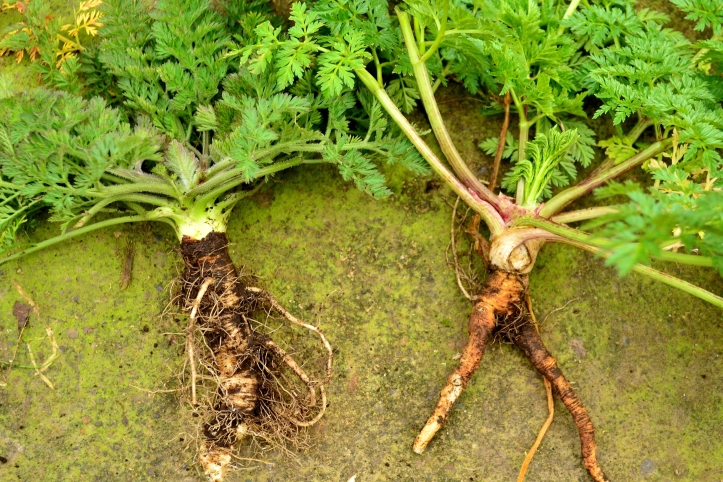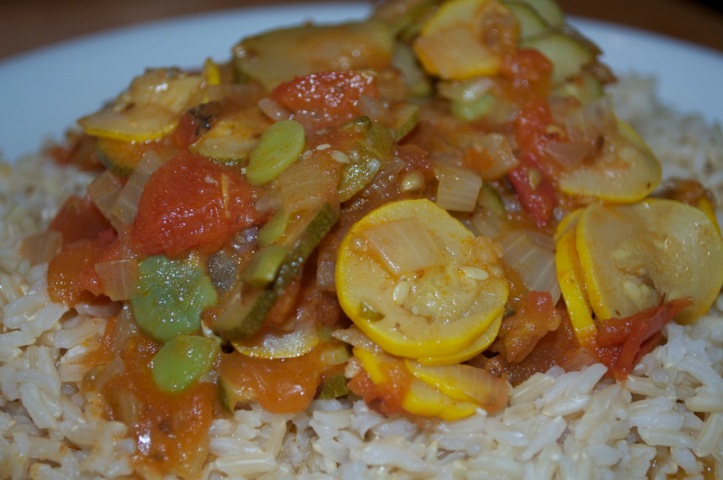Daucus carota

Queen Anne’s Lace is yet another weed often reminding me of childhood. More often than not I would spot an occasional ant crawling around the blossom, which at that time, led me to believe its name to be “Queen Ants Lace”. I reasoned that the single purple flower must represent the Queen and the worker ants walked the flower to pay tribute. You gotta love a child’s logic! Even so, I can remember pulling up the plant and smelling the very distinguishable carroty aroma from its roots. I even confronted my Mother about this discovery. However she made it very clear that I should not eat it, as it was “poisonous”. It wouldn’t be for another 16 years till I reconsidered its edibility.

Did you know?
Queen Anne’s Lace real name is Daucus carota and is actually a wild version of the domestically farmed Carrot! It was years of selective breeding which has transformed the wild carrot into the larger, sweeter, and more crisp version that we’re all familiar with. The species name carota is latin for Carrot which has been recognized by the Old World as a food and medicine throughout the ages. All parts are edible providing a wide range of culinary uses.

Wild Carrot is a biannual growing its vegetation the first year, sending up a flower stalk and going to seed in the second year. First year roots are best harvested in the spring or fall when they are most tender. Second year roots will become stringy and woody as the plant fully matures. However during this time the flower stalk can be peeled and eaten as a crisp ‘carrot flavored’ vegetable either raw or cooked. The flower itself can be used as a flavoring agent, to garnish meals, or eaten as a vegetable, and the seeds may be used as a spice or brewed for tea.

Carrot is a great source of Beta-carotene (Vitamin A), Vitamin K, C, Biotin, Carbohydrates and natural Sugar. Its nutritional content promotes a healthy immune system, healthy eyes, hair, skin and nails. (For a great article on the many benefits of Carrots as well as a complete nutritional analysis click HERE)


Traditionally,
Daucus carota has been used to treat the bladder, kidney and liver. It has been reported to increase the flow of urine helping in the aid of kidney waste removal, countering the formation of kidney stones. The leaves have been reported to act as an aphrodisiac, while the plant may delay menstruation. The seeds are an old-time contraceptive and should not be used by pregnant women. An essential oil from the seeds can be applied to counter wrinkles.
More medicinal information can be found in the following articles:
http://www.permaculture.co.uk/articles/look-powerful-medicinal-properties-wild-carrots
http://www.altnature.com/gallery/wildcarrot.htm
http://botanical.com/botanical/mgmh/c/carwil25.html
Wild Carrot and its Poisonous cousin.

If you are relatively new at foraging you may discover what is known as a “lookalike”. Knowing the desired plant intimately will help you avoid mistaking it with any imposters. Wild Carrot may have a few different lookalikes but often times its spotted growing in close proximity with Poison Hemlock. Observe the photos below to see the most significant differences between these two relatives of the Parsley.






The most significant identifiable feature of the Wild Carrot is its carroty aroma. Crack a root in half and take a good whiff… ah… carrot! Poison Hemlock, Fools Parsley and Yarrow as well as carota’s many other lookalikes simply lack that intense carrot scent, if not smelling entirely different at all. With some practice of comparison, soon you can enjoy this widely abundant and highly nutritious root vegetable.
To learn more about identifying wild carrot plus  many more wild edibles of North America be sure to check out Nature’s Garden by Samuel Thayer. His book is pack FULL of detailed colored pictures, complete plant descriptions, poisonous lookalikes comparisons, growing season timetables, and its a fun read altogether. It has helped motivate me on multiple occasions and has given me the confidence to get out and forage! I recommend this to both the beginner forager as well the experienced. If you are searching for a competent foraging reference you can click on the following link to where its available for purchase on Amazon.
many more wild edibles of North America be sure to check out Nature’s Garden by Samuel Thayer. His book is pack FULL of detailed colored pictures, complete plant descriptions, poisonous lookalikes comparisons, growing season timetables, and its a fun read altogether. It has helped motivate me on multiple occasions and has given me the confidence to get out and forage! I recommend this to both the beginner forager as well the experienced. If you are searching for a competent foraging reference you can click on the following link to where its available for purchase on Amazon.
Nature’s Harvest by Samuel Thayer
Thanks for stopping by, till next time
Happy Foraging!
-Hank
Remember…
If you ever have any doubt identifying, simply do not eat it!
Recipes
Click on a picture for the following recipes.





[…] be confident in the noticeable differences between Wild Carrot and Poison Hemlock – please read this page for guidance and more if you are a forager. Or this article. All parts of this plant are edible providing a wide range of culinary uses. If […]
LikeLike
[…] Identification for C… on Wild Carrot – Queen Anne… […]
LikeLike
[…] and breed them into something more presentable. Some people still like eating wild carrots, but be careful not to mistake them for poisonous […]
LikeLike
[…] and breed them into something more presentable. Some people still like eating wild carrots, but be careful not to mistake them for poisonous […]
LikeLike
[…] thenorthwestforager […]
LikeLike
[…] and breed them into something more presentable. Some people still like eating wild carrots, but be careful not to mistake them for poisonous […]
LikeLike
Excellent post and really useful photos, thank you!
LikeLike
Reblogged this on Noxious Weed News and commented:
Wild carrot is often confused with poison-hemlock, especially in the spring. This post has excellent photos and information to keep people from making a terrible mistake between an edible plant and a poisonous one.
LikeLike
[…] distinct, closely-bunched, flat-topped flower head. I was always told it was poisonous (not unlike Henry Holly), but have since learned that isn’t […]
LikeLike
[…] (c) thenorthwestforager.com […]
LikeLike
I’ve never seen any wild carrot flowers with a purple or red center flower the ones that grow wild here the whole flower is white with no red or purple center flower just white and smell just like carrots
LikeLike
excellent blog.thank for being out there love bushcraft-scotland.com look me up if ever make over to scotland
LikeLiked by 1 person
[…] distinct, closely-bunched, flat-topped flower head. I was always told it was poisonous (not unlike Henry Holly), but have since learned that isn’t […]
LikeLike
This is so interesting! Looking at the root structures I have definitely pulled up both wild carrot and poison hemlock on my property – I assumed they were both hemlock and the one with purple splotches was carrying some kind of disease. Now I can rip out the hemlock and let the carrots grow! 😀
LikeLike
Thank you for the very thorough description of the difference –
LikeLike